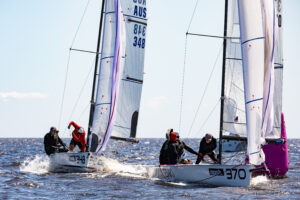

There are 3 simple rules for how to sail faster. It’s easy to overcomplicate sailing, so let’s look at these simple rules to keep you focused on more speed.
1. Sail In More Wind
Make sailing in more wind your number one priority. Dark patches on the water represent more wind. Wear polarised sunglasses to help you see the distinction between puffs and lulls on the water.
Stand on the boom in a keelboat and scan the course for the most wind. If you’re dinghy sailing, stand up to get higher so you can see further up the course.
You should always be asking yourself, “Am I sailing in the most wind available to me on the course that I am sailing?”
Having a clear lane gives you more wind as well. Wind follows the path of least resistance; it will flow over and around groups of boats. Remember, the bigger the group, the greater the effect, so avoid packs of boats, and you’ll have more wind.
If another boat tacks or gybes on you and closes down your lane, don’t sit in their shadow, gybe or tack away and find a better lane.
There may be a time when you consider sailing in a bad lane. This could happen when it is very shifty and the potential gain from the next shift outweighs the loss of speed. A 20 to 30 degree shift with pressure may justify sailing in bad air briefly.
2. Sail to the Mark
Your heading on one tack or gybe will point your bow more toward the mark than the other. The plan should nearly always be “Sail the long tack first”
This is the lifted tack upwind and the headed gybe downwind. The rule of thumb is to tack on headers upwind and gybe on lifts downwind.
If the wind is shifting or the course isn’t square, ask yourself, “If I were to tack or gybe now, would I be aiming more toward the mark?” This helps you make sure that you are always on the long tack.
If you are not sailing the long tack, make sure there is a very good reason.
A couple of good reasons to sail the short tack first are that you’re sailing toward more wind, getting a better lane, or sailing towards a significant gain, such as favourable current or a geographic shift.
Another exception is sailing into a heading persistent shift, but these are somewhat rare.
3. Keep it Simple
Keeping it simple means avoiding crowds, not tacking or gybing too much, and avoiding drama.
Minimise maneuvers as they slow you down, so doing fewer of them will help you go fast. In other words, sail straight and sail fast.
Avoid drama when you encounter another boat on the course; get in the habit of waving them through if you want a particular side of the course, even if you have rights.
There is nothing worse than forcing another boat to tack or gybe and then being lee bowed or becoming entangled in a hurried and failed crash gybe.

